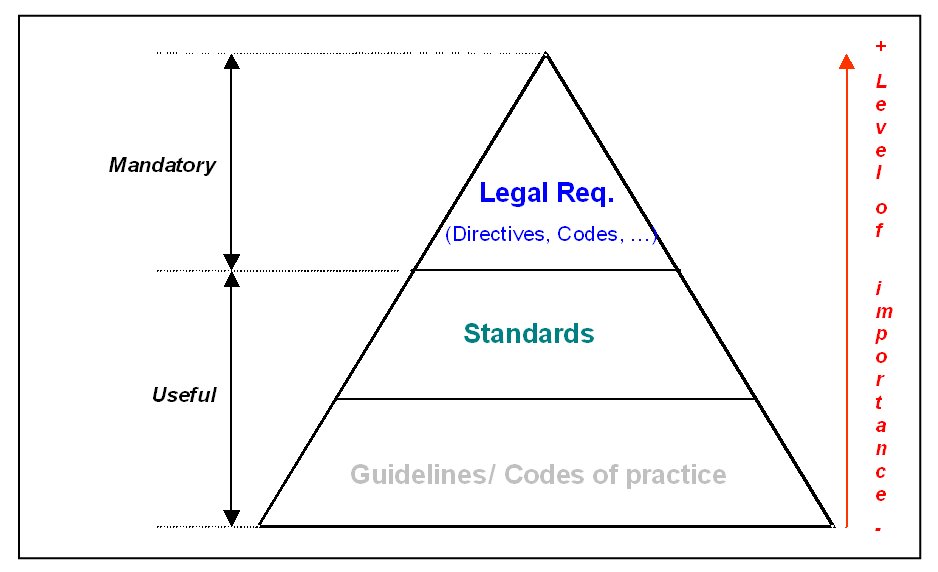
|
BRHS /
DefinitionsGeneral Figure 1. As shown in the figure above, the main difference between legal requirements and standards is their legal status. Legal requirements are made by political bodies (parliaments, governments), they are legally binding, and prescribe an acceptable level of, for example, safety or emissions for the technology in question. In contrast following standards are voluntary, but they are a useful instrument for the industrial organisations or interest groups dealing with the technology in question. Persons looking for technical advice will probably find it rather in the documents of lower legal rank. The task of parliaments or governments is not to think about a suitable wall thickness or the necessity of burst disks but rather to care for the legal framework. Legal RequirementsA legal requirement (directive, regulation or code, etc.) is a local, national, regional (e. g. European), or supra-national (e. g. UN ECE) statutory text which is imposed by a legal authority. It states requirements that are written and adopted by legislative bodies, so as to regulate a particular kind of activity. Legal requirements are intended to ensure that a product or system or activity will not impact on the human safety / health or on the environment. StandardsA standard as discussed in this report is a document, established by consensus and approved by a recognised body (Standard Drafting Organisation – SDO), that provides, for common and repeated use, rules, guidelines or characteristics for activities or their results, aimed at the achievement of the optimum degree of order in a given context. An international standard is a standard developed and adopted by an international standardisation organisation (like ISO or IEC) and made available to the public. The application of a standard is not obligatory, unless a regulation refers to that standard. Even then the legal power comes from the regulation, not from the standard. DistinctionThough standards and regulations are frequently mentioned together it should be remembered that they are two fundamentally different concepts. While regulations are mandatory for everybody in its domain, standards are not. Standards facilitate the trade and use of goods or services. Their main role is to make components or services fit together: pressure cylinders with valves, valves with regulators and further equipment leading the gas to the place of use. This, however, also involves safety issues, and so there is of course an interface with regulations. The following table highlights the most important characteristics of legal requirements and standards:
OthersCodeIn legal terms, a code is a collection of rules, requirements or standards that have been made binding and mandatory by a local or national government (as defined in the ISO / TR 15916). They are frequently proposed by recognized public or private bodies for the benefit of the relevant authorities. In practical use of language the term code often refers to a North American document. In this report, we distinguish “code” (with compelling power) and “code of practice” (which is a voluntary instrument – see paragraph 6.1.5.2 “Code of practice”). Code of practiceCodes of practice are usually a set of best practices for a specific product or system so as to ensure safe handling, maintenance and operation. Codes of practice are usually developed by industry specific organisations. GuidelineA guideline or a guide is a document generally written for a given organisation, whether for its own needs, or for its customers’ needs. Guidelines provide guidance to appropriate behaviour so as to ensure safety of people (workers, users and general public). It may also give information about codes, standards and regulations to comply with and about the recommended way to meet those requirements. For example, it gives information related to material properties, adequate installation, use of equipment and safety procedures. Guidelines may be aimed at:
Of particular importance are guidelines in the framework of the European Union where they give a compelling basis for the harmonization of the national laws of the member states in a certain field. This and examples of relevant guidelines will be discussed in detail under item 6.3 “Regulations”. State of the artState of the art is a term rather than a type of document and is the most advance technique or method used at a given time. Best engineering practiceBest engineering practice is a term but may also refer to a document and means the best practices performed in the design, construction, or operation of structures, machines, or other devices of industry and everyday life. Best engineering practices are defined from the industrial organisations and key implementors of a given technology. << List of Contributors | Content | Global Agreements on Road Vehicles >> |